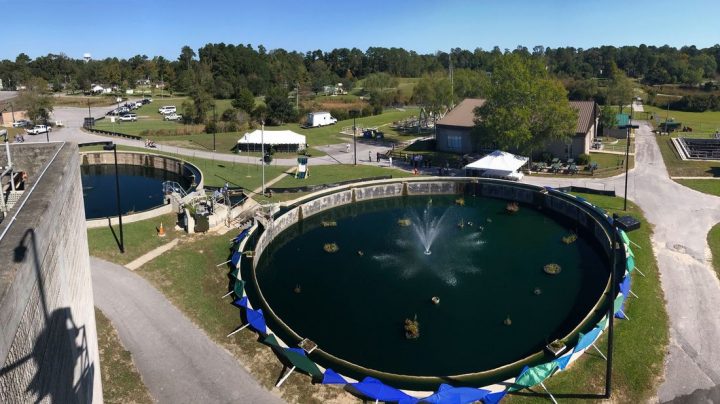
JACKSONVILLE – The long, rectangular concrete slab may not look like much today, but the foundation of Sturgeon City’s new learning center is a major step for program expansion and opportunities for the nonprofit.
“We’re very excited and looking forward to getting this new building,” said Paula Farnell, Sturgeon City’s director of development and operations.
Supporter Spotlight
Under construction is an 11,000-square-foot facility that will house a main hall spanning 5,400 square feet – space large enough to accommodate 450 to 500 people and events such as educational classes, conferences and weddings.
“The mission of Sturgeon City is to become the model for inspiring youth leadership, civic involvement, habitat restoration, environmental education and stewardship of the New River and coastal wetlands.”
sturgeoncity.org
The indoor meeting space alone is significantly larger than Sturgeon City’s current learning center, which spans a mere 1,500 square feet.
“We have limited capacity now,” Farnell said. “We often, like when a larger school comes to visit, they have to send their classes over different days. Now we’ll have the ability to run multiple programs on the same days.”
The $3.2 million building is a long-awaited addition to the grounds of the former wastewater treatment plant overlooking the end of Wilson Bay on the New River in downtown Jacksonville.
The new learning center will sit among the former plant’s original structures where tens of thousands of gallons of raw sewage once sifted and churned.
Supporter Spotlight
Sturgeon City’s visionaries determined years ago to repurpose the old concrete structures on the site, which is a teaching ground and a memorial to how one community pulled together to reverse the devastation caused by years of dumping sewage into the bay.

Photo: Courtesy Paula Farnell, Sturgeon City
In one area of the 26-acre site rests a square, two-story bio tower; four large round holding tanks; and a series of drying beds tucked between the administration building to the water’s edge.
The words “Greater Jacksonville Wastewater Treatment Facility” – another reminder of the past – remain over the administration building’s double glass doors.
More than 170 truckloads of black plastic “bio balls” used to filter wastewater have been removed from the bio tower and hauled to a landfill.
“There had been some thought as to whether [the bio balls] would be reusable,” Farnell said.
But as the tedious removal began, staff discovered that the plastic balls were not meant for dry conditions and the cracked, plastic casings could not be salvaged.
The hope is to reuse the bio tower, once the highest point in Jacksonville, as exhibit space. Construction crews are in the process of securing the tower’s roof to use as an observation deck.
Sturgeon City was founded in 2000 as an environmental teaching ground and today it hosts between 60 and 80 programs. Hundreds of school-age children visit the site annually through field trips. During the summer season, a variety of environmental and science camps are held on site.
Now upwards of 8,000 to 9,000 children visit the site to participate in programs designed to enhance their knowledge about science, aquaculture, math and forensics and encourage them to volunteer.
The nonprofit even offers a monthly “parents’ night out,” where one Friday of each month children may be dropped off to enjoy hands-on educational programs for a nominal fee.

“We’ve grown quite a bit since 2005-2006, when we started a majority of our programs,” Farnell said.
Half of the land, once a landfill, is a park with picnic tables, a playground and walkways leading to the bay. Nine acres of wetlands have been restored along Sturgeon City’s banks.
Over the years, the site has also been used for research, but Farnell said staff is focusing primarily on the educational component.
Currently, the campus is housing an oyster restoration project run by the city’s storm water department. Three oyster reefs, including about eight million oysters, have been constructed in the bay, Farnell said.
Sturgeon City’s beginnings stem from efforts that began decades ago to clean the bay.

In the 1990s, the city and North Carolina State University began the Wilson Bay initiative, a project aimed at restoring aquatic life to the bay after treated sewage had been dumped into it for more than 40 years.
After closing the plant, city leaders intended to raze its structures and possibly sell the land. A scientist working on the bay initiative came up with the idea to use the plant’s large tanks to raise Atlantic sturgeon, bottom feeders that once thrived in the bay.
Raising and releasing the fish into the wild isn’t permitted.
In recent years, there has been the occasional siting of Sturgeon, but they have been few and far between.
“They’re very sensitive to water quality,” Farnell said. “Simply getting the water quality healthy isn’t going to be enough to bring them back to what they were here.”
Koi, which have been placed in two of the large tanks, are the only fish visitors will see on the grounds.
As the facility expands, the hope is that so too will the outreach and educational programs at Sturgeon City, Farnell said.
“We’re hoping as our capacity grows, it will grow more,” she said.
The new learning center is estimated to be complete by the end of the year and open for use by the spring of 2019.







